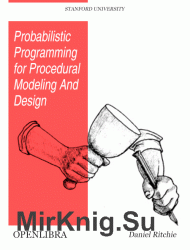
Название: Probabilistic Programming for Procedural Modeling and Design
Автор: Daniel Ritchie
Издательство: Standford University
Год: 2016
Формат: pdf
Страниц: 152
Размер: 43 mb.
Язык: English
Procedural modeling, or the use of pseudo-random programs to generate visual content, plays an important role in computer graphics and design. It facilitates content creation at massive scales, can automatically create painstakingly-detailed imagery, and can even generate pleasantly surprising results that can help people to navigate large and unintuitive design spaces
Many procedural modeling applications demand directable content—the ability to enforce aesthetic or functional constraints on model output. Bayesian inference provides a framework for such control: the procedural model specifies a generative prior, with the constraints encoded as a likelihood function.
In this dissertation, we use probabilistic programming languages to express such Bayesian procedural models. A probabilistic programming language (PPL) provides random choice and Bayesian conditioning operators as primitives, and inference corresponds to searching the space of program executions for high-probability execution traces. PPLs can concisely express arbitrary probability distributions, including the complex, hierarchical, and often recursive stochastic processes required in procedural modeling.
Unfortunately, PPL inference is typically inefficient, relying on expensive Monte Carlo methods. This dissertation develops a suite a of techniques for speeding up PPL inference. First, we eliminate redundant computation from Metropolis-Hastings, one of the most commonly used PPL inference algorithms. Next, we show how to efficiently explore tightly-constrained design spaces using the gradient-based, Hamiltonian Monte Carlo algorithm. Then, we address the problems posed by deep branching structures in procedural models such as recursive trees, using a new variant of Sequential Monte Carlo. Finally, we make procedural modeling programs learn from their own outputs, using neural networks that guide programs toward high-probability results with fewer samples. Together, these tools bring PPL inference closer to interactive rates, which can enable more compelling graphics and design applications.